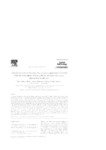Por favor, use este identificador para citar o enlazar este ítem:
http://www.alice.cnptia.embrapa.br/alice/handle/doc/485544Registro completo de metadatos
| Campo DC | Valor | Lengua/Idioma |
|---|---|---|
| dc.contributor.author | MOTA, F. F. da | pt_BR |
| dc.contributor.author | NOBREGA, F. F. | pt_BR |
| dc.contributor.author | MARRIEL, I. E. | pt_BR |
| dc.contributor.author | PAIVA, E. | pt_BR |
| dc.contributor.author | SELDIN, L. | pt_BR |
| dc.date.accessioned | 2017-06-06T23:48:11Z | - |
| dc.date.available | 2017-06-06T23:48:11Z | - |
| dc.date.created | 2002-08-29 | pt_BR |
| dc.date.issued | 2002 | pt_BR |
| dc.identifier.citation | Applied Soil Ecology, Amsterdam, v. 20, n. 2, p. 119-132, 2002. | pt_BR |
| dc.identifier.uri | http://www.alice.cnptia.embrapa.br/alice/handle/doc/485544 | pt_BR |
| dc.description | A tropical Brazilian soil (Cerrado) was planted with four cultivars of maize (CMS04, CMS11, CMS22 and CMS36) and the genetic diversity of the Paenibacillus polymyxa populations present in their rhizospheres was determined after 90 days of sowing. For that, a total of 67 isolates were identified as R polymyxa by classical biochemical tests and were analyzed for DNA polymorphism with the randomly amplified polymorphic DNA (RAPD) and amplification of repetitive DNA sequences (rep) methods. The amplification patterns obtained using three arbitrary primers and the primer BOXA1R were used separately to construct dendrograms based on the unweighted pair groups method with arithmetic means (UPGMA). Fifty-four genotypic groups were formed when data from different PCR amplification were combined, showing a high level of genetic polymorphism among P. polymyxa strains. A dendrogram based also on combined PCR data, followed by cluster analysis with minimum-variance criteria (Ward) and Euclidean distance, showed that P. polymyxa strains could be divided into two main clusters. One cluster was formed predominantly by strains from maize cultivars CMS04 and CMS36, while the other cluster was formed predominantly by strains of maize cultivars CMS11 and CMS22. Multivariate analysis of variance (MANOVA) allowed the correlation between the genetic structure of P. polymyxa populations and the different cultivars of maize to be studied. The results showed that the strains isolated from the rhizospheres of the different maize cultivars were significantly different. (C) 2002 Elsevier Science B. V. Alls rights reserved. | pt_BR |
| dc.language.iso | eng | eng |
| dc.rights | openAccess | eng |
| dc.subject | Diversidade genetica | pt_BR |
| dc.title | Genetic diversity of Paenibacillus polymyxa populations isolated from the rhizosphere of four cultivars of maize (Zea mays) planted in cerrado soil. | pt_BR |
| dc.type | Artigo de periódico | pt_BR |
| dc.date.updated | 2018-06-07T11:11:11Z | pt_BR |
| dc.subject.thesagro | Bactéria | pt_BR |
| dc.subject.thesagro | Cerrado | pt_BR |
| dc.subject.thesagro | Milho | pt_BR |
| dc.subject.thesagro | Rizosfera | pt_BR |
| riaa.ainfo.id | 485544 | pt_BR |
| riaa.ainfo.lastupdate | 2018-06-07 -03:00:00 | pt_BR |
| dc.contributor.institution | IVANILDO EVODIO MARRIEL, CNPMS. | pt_BR |
| Aparece en las colecciones: | Artigo em periódico indexado (CNPMS)  | |
Ficheros en este ítem:
| Fichero | Descripción | Tamaño | Formato | |
|---|---|---|---|---|
| Geneticdiversity1.pdf | 148,63 kB | Adobe PDF |  Visualizar/Abrir |









